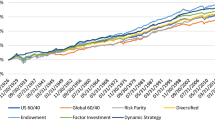Summary
Dynamic portfolio models have obtained a prominent place in the economic literature. As a rule, the problem of implausible long-term coefficients is ignored. In particular the long-term interest rate parameters are not in accordance with the theory of gross substitution. This shortcoming is especially serious when such a portfolio model is used as part of a larger macroeconomic model. A standard estimation-under-restriction procedure cannot be applied as these long-term coefficients are nonlinear functions of short-term interest rate coefficients and of the coefficients of the adjustment process. This paper introduces a new estimation procedure, which is used to estimate portfolio models for households and banks in The Netherlands.
Similar content being viewed by others
References
Backus, D., and D. Purvis (1980), ‘An Integrated Model of Household Flow-of-funds Allocations,’Journal of Money, Credit and Banking, 12, pp. 400–421.
Backus, D., W.C. Brainard, G. Smith and J. Tobin (1980), ‘A Model of US Financial and Nonfinancial Economic Behaviour,’Journal of Money, Credit and Banking, 12, pp. 259–293.
Bettendorf, L. and D. van de Gear (1991), ‘Dynamic Portfolio Models,’Economic and Financial Computations, 3, pp. 291–301.
Brainard, W.C. and J. Tobin (1968), ‘Pitfalls in Financial Models Building,’American Economic Review, 58, pp. 99–122.
Christofides, L.N. (1976), ‘Quadratic Costs and Multi-asset Partial Adjustment Equations,’Applied Economics, 8, pp. 301–305.
Conrad, K. (1980), ‘An Application of Duality Theory: A Portfolio Composition of the West-German Private Non-bank Sector, 1968–1975,’European Economic Review, 13, pp. 163–187.
Courakis, A.S. (1975), ‘Testing Theories of Discount House Portfolio Selection,’Review of Economic Studies, 42, pp. 643–648.
Courakis, A.S. (1988), ‘Modelling Portfolio Selection,’Economic Journal, 98, pp. 619–642.
Dalal, A.J. (1983), ‘Comparative Statics and Asset Substitutability, Complementarity in a Portfolio Model: A Dual Approach,’Review of Economic Studies, 50, pp. 355–367.
Fase, M.M.G. (1978), ‘Een verdeelmodel voor liquide activa,’Economisch-Statistische Berichten, 63, pp. 215–218.
Fase, M.M.G. (1979), ‘The Demand for Financial Assets: Time Series Evidence for The Netherlands, 1963:II-1975:IV,European Economic Review, 12, pp. 381–394.
Fase, M.M.G. (1981), ‘Financiële activa, rentevorming en monetaire beheersbaarheid: proeve van een monetair kwartaalmodel voor Nederland,’ in: E. den Dunnen, M.M.G. Fase and A. Szász (eds.),Zoeklicht op beleid, Leiden/Antwerp, pp. 43–81.
Fase, M.M.G. (1984), ‘The Monetary Sector of The Netherlands in 50 Equations,’ in: J.P. Ancot (ed.),Analysing the Structure of Econometric Models, Advanced Studies in Theoretical and Applied Econometrics, 2, The Hague.
Fase, M.M.G. and C.C.A. Winder (1990), ‘The Demand for Money in The Netherlands Revisited,’De Economist, 138, pp. 276–301.
Fase, M.M.G., P. Kramer and W.C. Boeschoten (1990),MORKMON II, het DNB kwartaalmodel voor Nederland, Monetaire Monografieën, 11, De Nederlandsche Bank NV, Amsterdam.
Fase, M.M.G., P. Kramer and W.C. Boeschoten (1992), ‘MORKMON II, The Nederlandsche Bank's Quarterly Model of The Netherlands' Economy,’Economic Modelling, 9, pp. 146–204.
Hunt, B.F. and M.R. Upcher (1979), ‘Generalized Adjustment of Asset Equations,’Australian Economic Papers, 18, pp. 308–321.
Hunt, B.F. and P.A. Volker (1980), ‘A Simplified Portfolio Analysis of the Long-run Demand for Money in Australia,Journal of Monetary Economics, 8, pp. 395–404.
Hylleberg, S., R.F. Engle, C.W.J. Granger and B.S. Yoo (1990), ‘Seasonal Integration and Cointegration,’Journal of Econometrics, 88, pp. 549–563.
Markowitz, H.M. (1952), ‘Portfolio Selection,’Journal of Finance, 7, pp. 77–91.
Markowitz, H.M. (1959),Portfolio Selection: Efficient Diversification of Investments, Cowles Foundation for Research in Economics Monograph, 16, New York.
Nederlandsche Bank, De (1984),MORKMON, een kwartaalmodel voor macro-economische beleidsanalyse, Monetaire Monografieën, 2, De Nederlandsche Bank NV, Amsterdam,
Ogawa, K., M. Saito and I. Tokutsu (1989), ‘The Flow-of-funds Equations of Japanese Banks,’Working Paper 8903, School of Business Adminstration, Kobe University, Japan.
Ogawa, K., M. Saito and I. Tokutsu (1989), ‘The Flow-of-funds Equations of Japanese Non-financial Firms,’Working Paper 8903, School of Business Administration, Kobe University, Japan.
Owen, D. (1986),Money, Wealth and Expenditure: Integrating Modelling of Consumption and Portfolio Behaviour, Cambridge.
Pagan, A.R., P. Hall and P.K. Trivedi (1983), ‘Assessing the Variability of Inflation,’Working Paper 45, Australian National University.
Roley, V.V. (1983), ‘Symmetry Restrictions in a System of Financial Asset Demands: Theoretical and Empirical Results,’Review of Economics and Statistics, 65, pp. 124–130.
Sharpe, I. (1973), ‘A Quarterly Econometric Model of Portfolio Choice-Part I: Specification and Estimation Problems,’Economic Record, 49, pp. 518–533.
Smith, G., (1975), ‘Pitfalls in Financial Model Building: A Clarification,’American Economic Review, 65, pp. 510–516.
Smith, G. and W.C. Brainard (1976), ‘The Value of a priori Information in Estimating a Financial Model,’Journal of Finance, 5, pp. 1299–1322.
Sterken, E. (1990),DUFIS: An Econometric Model of the Dutch Financial System (Ph. D. thesis), Rijksuniversiteit Groningen.
Taylor, J.C. and K.W. Clements (1983), ‘A Simple Portfolio Allocation Model of Financial Wealth,’European Economic Review, 23, pp. 241–251.
Theil, H. and A.S. Goldberger (1961), ‘On Pure and Mixed Statistical Estimation in Economics,’International Economic Review, 2, pp. 65–78.
Tobin, J. (1958), ‘Liquidity Preference as Behavior Toward Risk,’Review of Economic Studies, 5, pp. 65–86.
Tobin, J. (1965), ‘The Theory of Portfolio Selection,’ in: F.H. Hahn and F.P.R. Brechlin (eds.),The Theory of Interest Rates, London.
Tobin, J. (1982), ‘Money and Finance in the Macroeconomic Process,’Journal of Money, Credit and Banking, 14, pp. 171–204.
Author information
Authors and Affiliations
Rights and permissions
About this article
Cite this article
Bikker, J.A., Van Els, P.J.A. Dynamic portfolio models with long-term restrictions. De Economist 141, 515–542 (1993). https://doi.org/10.1007/BF02375170
Issue Date:
DOI: https://doi.org/10.1007/BF02375170




